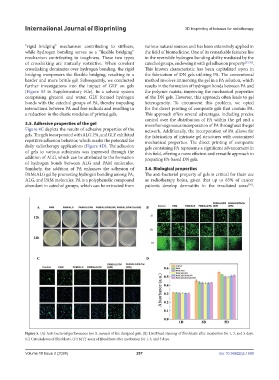Page 265 - IJB-10-2
P. 265
International Journal of Bioprinting 3D bioprinting of boluses for radiotherapy
“rigid bridging” mechanism contributing to stiffness, various natural sources and has been extensively applied in
while hydrogen bonding serves as a “flexible bridging” the field of biomedicine. One of its remarkable features lies
mechanism contributing to toughness. These two types in the reversible hydrogen bonding ability mediated by the
of crosslinking are mutually restrictive. When covalent catechol groups, endowing it with gel adhesion property [37,38] .
crosslinking dominates over hydrogen bonding, the rigid This known characteristic has been capitalized upon in
bridging overpowers the flexible bridging, resulting in a the fabrication of DN gels utilizing PA. The conventional
harder and more brittle gel. Subsequently, we conducted method involves immersing the gel in a PA solution, which
further investigations into the impact of GLY on gels results in the formation of hydrogen bonds between PA and
(Figure S3 in Supplementary File). In a solvent system the polymer matrix, improving the mechanical properties
comprising glycerol and water, GLY formed hydrogen of the DN gels. However, this approach often leads to gel
bonds with the catechol groups of PA, thereby impeding heterogeneity. To circumvent this problem, we opted
interactions between PA and free radicals and resulting in for the direct printing of composite gels that contain PA.
a reduction in the elastic modulus of printed gels. This approach offers several advantages, including precise
control over the distribution of PA within the gel and a
3.5. Adhesive properties of the gel more homogeneous incorporation of PA throughout the gel
Figure 4C depicts the results of adhesive properties of the network. Additionally, the incorporation of PA allows for
gels. The gels incorporated with ALG, PA, and GLY exhibited the fabrication of intricate gel structures with customized
repetitive adhesion behavior, which marks the potential for mechanical properties. The direct printing of composite
daily radiotherapy applications (Figure 4D). The adhesion gels containing PA represents a significant advancement in
of gels to various substrates was improved through the this field, offering a more efficient and versatile approach to
addition of ALG, which can be attributed to the formation preparing PA-based DN gels.
of hydrogen bonds between ALG and PAM molecules.
Similarly, the addition of PA enhances the adhesion of 3.6. Biological properties
PAM/ALG gel by promoting hydrogen bonding among PA, The anti-bacterial property of gels is critical for their use
ALG, and PAM molecules. PA is a polyphenolic compound as radiotherapy bolus, given that up to 85% of cancer
abundant in catechol groups, which can be extracted from patients develop dermatitis in the irradiated areas .
[39]
Figure 5. (A) Anti-bacterial performance (on S. aureus) of the designed gels. (B) Live/Dead staining of fibroblasts after incubation for 1, 3, and 5 days.
(C) Cytoskeleton of fibroblasts. (D) MTT assay of fibroblasts after incubation for 1, 3, and 5 days.
Volume 10 Issue 2 (2024) 257 doi: 10.36922/ijb.1589

